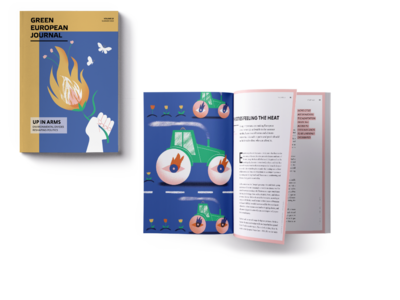From national leaders calling for a pause to the European Green Deal to the online Right’s re-invention of the “15-minute city” as an authoritarian project for social control, the signs of an anti-green backlash are growing.
Climate politics had been resurgent in Europe since 2018. The need for governments and society to take serious, rapid action to reduce greenhouse gas emissions was reflected in public debate, street demonstrations and election results, and the commitments that politicians were increasingly ready to sign up to. The sense of urgency was real, possibly even genuine.
That momentum is today faltering, replaced by hesitation and the sense that European societies cannot cope with the speed and scale of change that the ecological crisis demands. At the European level, the French and German governments both intervened to water down parts of legislation in line with their national interests, while the centre-right European People’s Party is concentrating its fire on the Green Deal agenda.
National politics continues to swing to the right, with green policies a key dividing line in a wider cultural battle. Climate activists are increasingly vilified for their disruptive actions. In an emblematic development, a new movement bankrolled by livestock farming interests upset the Dutch political scene in the spring of 2023. Successfully channelling rural disaffection against mismanaged environmental policies, this force now wields significant influence.
“The ecological transition involves dismantling one world while building another,” Héctor Tejero explains in this edition. No wonder such conflicts are emerging. Despite the mood turning away from green policies, the climate crisis continues to deepen. Its worsening impacts mean that political action cannot be put off. After all, it is decades of delay and wishful thinking that compels governments to take radical and unpopular steps.
Compared to the heady days of the Green Wave, it is clear that green politics in Europe has entered a new phase. The challenge for the green movement is no longer that of convincing society that something needs to change – that effort was broadly successful. The question now is how exactly. How fast do changes need to happen, which technologies should we invest in, who pays and who profits? A whole series of practical, technical, and eminently political dilemmas around the shape of the transition are upon us. Most importantly, how can a base of support wide enough for its success be built and maintained?
As this edition explores, social divides layered and deepened by environmental questions are today at the heart of politics. Old cleavages take on a new shape. In a Europe of annual heatwaves, for example, who has access to cool, liveable temperatures in the city heat becomes as much a matter of social justice as who can afford to heat their home in winter. Longstanding territorial inequalities take on new dimensions. As renewable energy requires a different material base from fossil fuels and is, so far, less storable, disputes over where mines and energy infrastructure will be located have emerged within and between countries. Even the supposedly disembodied digital world cannot escape the reality of geography and resources.
These new environmental divides are not just a matter for national politics: the transformations implied by climate change and the energy transition are reshaping global politics too. A global industrial race has begun between China, the EU, and the United States to control the production of green technologies, particularly electric cars. It will have deep implications for millions of European manufacturing workers. Similarly, the choices Europe has made to manage its post-2022 energy crisis are affecting social and environmental realities globally, now that earlier pledges to stop investing in fossil fuels have been abandoned. The war in Ukraine itself is cut with environmental dimensions, from the oil and gas funding Putin’s war to the impacts of the surging global arms expenditure and the mineral wealth at stake in the fighting.
The Greens, whose politics is built around reconciling the social and ecological, have always argued that we live in a world of environmental divides. However, this understanding might not be a sufficient guide. As the political force most associated with the environmental cause, Greens will be expected to provide answers for the conflicts and inequalities of the transition and will be blamed if they don’t.
Fights over the specifics of green policy are in some ways the growing pains of success. Political ecology as a current of thought, though not without its controversies, continues to develop around fundamental principles and a political horizon. However, the string of national elections won by the Right and the broader readiness to delay and jettison environmental policies prompt the question: how can political ecology move from wielding a certain cultural influence capable of initiating limited policy changes to leading a broad social coalition built around resolving the fault lines of the transition?
This edition answers this challenge by recognising the costs, trade-offs and dilemmas that the green transformation of society entails and mapping different political struggles around them. As Green experiences in government are showing, no solution is environmentally or socially perfect, choices have to be made between different metrics, and there are costs as well as opportunities. Green leadership can distinguish itself by not ignoring changes that need to happen and pushing choices further into the future, but by offering a practical and socially just way forward.
A special thank you to Seden Anlar who, as communications and outreach manager, brought the Green European Journal to more readers than ever online and in print, helping make sure you can get this copy in your hands. We know she will create similar lasting impacts in her new role and we wish her the very best on the journey.

